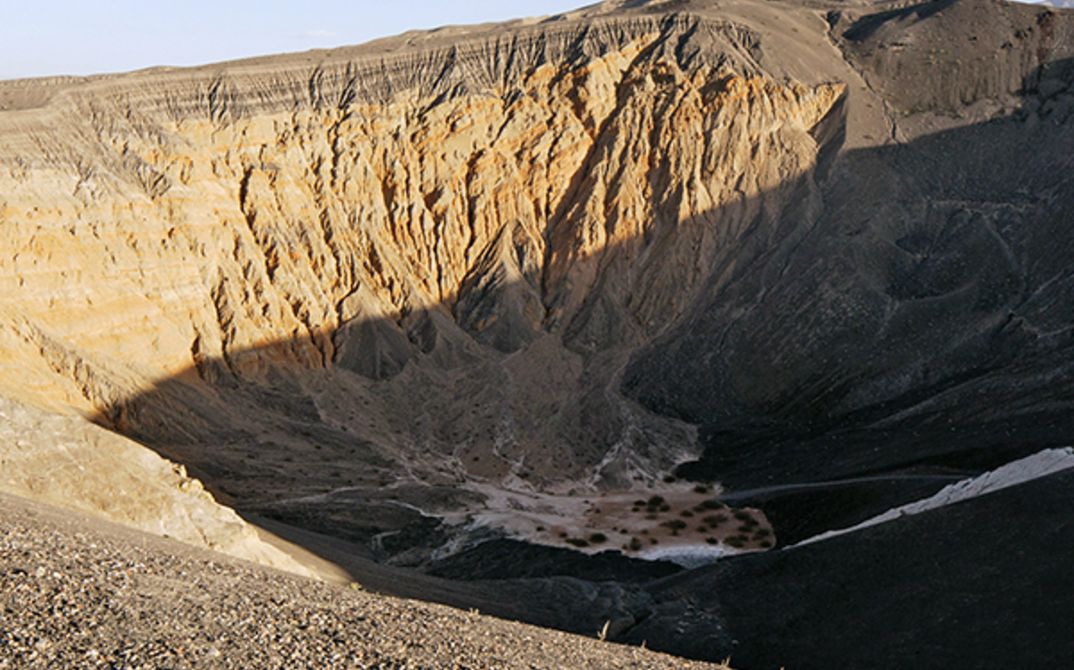35mm film installation, 9 min. silent.
Two cameras circle the Ubehebe crater in Death Valley on opposite sides. The cameras move at the speed of the sun, taking a still image every 20 seconds from sunrise to sunset to produce two half circles made up of 2931 single frames.
To a geologist the 150 meter deep crater is the consequence of a hydrovolcanic explosion over 7000 years ago. For the Timbisha Shoshone, who have inhabited Death Valley for over 1000 years, the crater is known as Wosa, meaning, “Coyote’s Burden Basket” and is a sacred space created by a weary Coyote.
“The people were small then, so Coyote kept them in a large basket he carried on his back. After a long journey, Coyote grew tired. When he came to a place at the north end of the valley, he set his burden down on the earth. The moment he fell asleep, the people climbed up out of the basket.” (Historic Preservation Committee of the Timbisha Shoshone Tribe)
The Timbisha Shoshone’s movement through the landscape as described in tales reveals a mythical-spiritual dimension to the ethos of sustainability. In settlers’ narratives or the National Park’s description of the crater this information is never mentioned and it is occluded from the micro-narratives of the region.
Heike Baranowsky, born in Augsburg, West Germany in 1966, lives in Berlin. She initially studied sculpture at the Akademie der Bildenden Künste München, then at the HfBK Hamburg and the UdK in Berlin, before completing an MA in Photography at the RCA in London. From 2001 to 2003 she lived in California, where she was visiting artist at the Art Center College of Design in Pasadena. From 2005 to 2008 she taught photography at the Kunsthøgskole i Bergen. Since 2008 she has been Professor for Fine Arts at the Akademie der Bildenden Künste Nürnberg.
Production Heike Baranowsky. Production company Heike Baranowsky (Berlin, Germany). Director Heike Baranowsky. Cinematography Volker Gläser. Editing Heike Baranowsky.
Films
1995: en face II (video installation, 5 min.). 1997: AUTO SCOPE 1996-1997 (video installation, 60 min.), In sight Out (video installation, 15 min.). 1998: death/breath tomb/womb evil/live (video installation, 20 min.), PASSAGE I (Schiff) (video installation, 3 min.), PASSAGE II (Zug) (video installation, 16 sec.), PASSAGE III (Bahnhof) (video installation, 1 min.). 1999: parallax (video installation, 28 sec.), Paraphrasen (Chinese New Year) (video installation, 27 sec.). 2000: Paraphrasen (Vogel) (video installation, 30 sec.), Paraphrasen (Heathrow) (video installation, 28 sec.), Schwimmerin (1:24) (video installation, 2 sec.), Radfahrer (Hase und Igel) (video installation, 8 sec.). 2001: Gras (video installation, 3 min.), Mondfahrt 2001 (video installation, 6 min.). 2004: EVER GREEN 2001-2004 (video installation, 34 sec.). 2002: Shape Shifter (video installation, 6 min.), Ballett (video installation, 3 min.), Blown in the Wind (video installation, 1 min.). 2003: Out of the Blue (video installation, 10 min.). 2005: Schwarm (video installation, 8 min.), Mariposa (video installation, 36 min.), Wasserball (video installation, 1 min.). 2006: T Square (with Waszem Khan, 16 min.), CUE 1 (video installation, 4 min.), Intervall (video installation, 3 min.), CUE 2 (video installation, 1 min.), Looming, (with Waszem Khan, video installation, 16 min.). 2008: probe (video installation, 15 min.). 2009: pêche (video installation, 11 min., Forum Expanded 2010). 2010: Racetrack (video installation, 4 min.). 2012: Barometer (i) (55 min., Forum Expanded 2012). 2013: Barometer (iiii) (video installation, 34 min.). 2014: Ich war der Schichtleiter E.G. Kienbaum (13 min.), KviKvi A Film Performance Film (5 min.). 2015: Krater (keri∂) (1 min.), KviKvi (video installation, 9 min.). 2016: Equinox (22 sec.). 2018: Coyote’s Burden Basket (video installation, 2 min.). 2019: Wosa (Coyote’s Burden Basket).
Photo: © Heike Baranowsky
